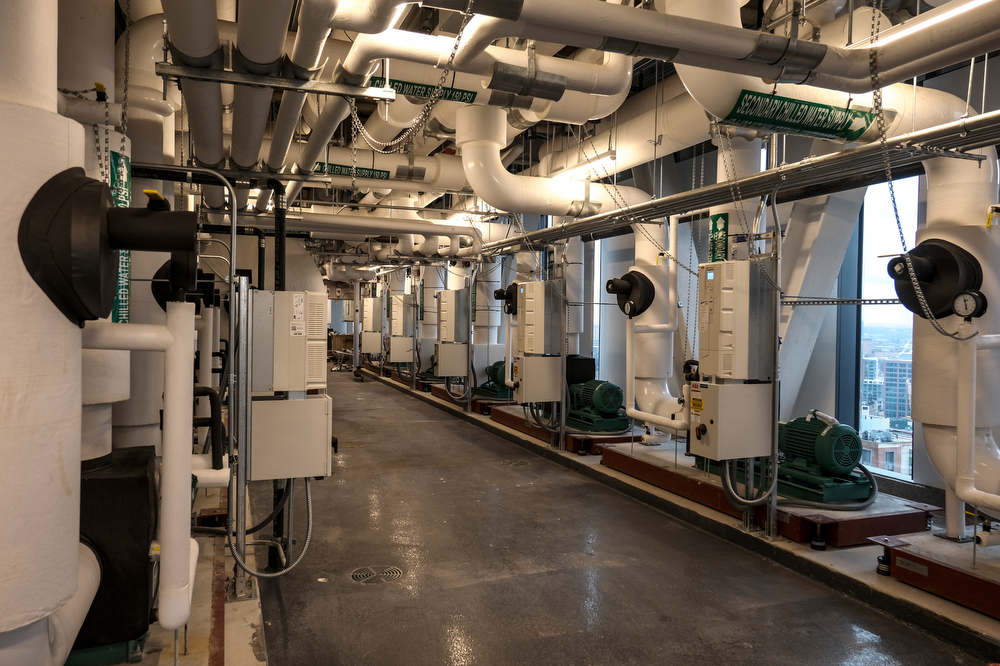Boston University’s Center for Computing & Data Sciences looks like no other building on the Boston skyline.
It’s also one of the largest fossil fuel-free ones — not just in Boston, but in all of New England.
The building, unveiled in December 2022, marked a monumental moment for sustainability in urban development. The CCDS is a large part of BU’s climate action plan, which aims to achieve net-zero carbon emissions by 2040.

“What I think makes this [the CCDS] stand out within the climate action plan, is that it’s a physical reminder of the broader work that we’re doing,” said Sam Moller, the assistant director of communications for BU Sustainability.
The CCDS uses a geothermal system to heat and cool the building — meaning there are no gas lines attached to the building.
“To achieve that in this kind of setting, like we are in a big city, is really really hard to do for a building of this scale,” Moller said.
Located on the east side of the CCDS building, there are 31 pipes, “ground source heat pumps,” extended 1,500 feet deep into the ground. The pipes allow for the heat from the earth to be stored and moved when needed, according to the CCDS virtual tour. The heat is transferred via “glycol water” contained inside the pipes.
In the summer, heat from the building is stored within the ground which is transferred by the water inside the heat pumps, according to the virtual tour. This allows the cooler energy to move and chill the building. During the winter, the heat stored in the ground is transferred upwards to warm the building.
“[Geothermal is] similar to what happens in your refrigerator,” said Rick Reibstein, a lecturer of environmental law and policy in the department of earth and environment at BU.
Reibstein said the ground source heat pumps work as a system to regulate the temperature in the building by coming into contact with the ground’s heat and moving around.
A risk of using geothermal energy is using a heat transfer chemical that isn’t safe, said Reibstein.
Lucy Timbers, the senior associate of KPMB Architects and project manager of the CCDS, wrote in an email, “propylene glycol is used for heating and cooling inside the building.” Propylene glycol is “generally recognized as safe” by the Food and Drug Administration. She added that the geothermal closed-loop tubes embedded in the ground use water.
“When we do something like geothermal, we have cleaner skies, we have healthier lungs, we have less hot climate,” Reibstein said.
The machines loudly whirring on the 18th floor of the building regulate the temperature of the building. The heat pumps are designed to cover 90% of the heating and cooling of the building. The other 10% uses energy created from BU’s wind farm in South Dakota to power electric boilers, which only turn on when needed.
Upon first entering the building, one immediately notices the “butterfly” staircase, named for its two wings. Sarah Healey, the zero waste manager at BU, said a glass-enclosed staircase — still in construction — will connect floors six through 17. This glass staircase is designed to be “an inviting space for people to walk up and down.”
On the outside of the building, the slanted panels on the exterior of the windows of the CCDS may look decorative but serve as shades to reduce glare from the sun, Moller said. Conversely, some sides of the building purposefully let light in.
“That’s actually an energy efficiency decision because when you utilize more natural light, you use less artificial lights,” Moller said.
The CCDS strives to eliminate carbon emissions at a foundational level. Preventing trash from ending up in landfills is also a significant part of sustainability.
Compost, recycling and trash bins with built-in sensors are implemented on each floor of the CCDS. The sensors allow a BU Sustainability team of student interns and staff to make an assessment of the waste by tracking what goes into the bins.
Healey said people don’t always follow the signs on the bins when they toss out their trash, leading to contamination that can interrupt the recycling process.
“We’re using those waste assessments to provide targeted education to the floors about how they can do better, and then we’re also giving them floor-specific data about how much waste they’re generating,” Healey said.
Each floor generates different kinds of waste. Some floors are concentrated with offices and smaller groups of people circulate through them. Others, such as the first to fifth floors, are more communal.
“So much of [zero waste] is based on human behavior, which is a really difficult thing to control and to change,” Healey said.
Currently, BU Sustainability interns are taking pictures of the insides of bins to perform waste assessments, but BU Sustainability is in the early stages of working with Spare-it, a Boston-based artificial intelligence company.
Even with the efforts to reduce waste by floor, Healey said about 50% of the waste produced in the CCDS is from the “back of house,” referring to waste produced by Saxby’s and catered events.
Many of the faculty members working in the CCDS are asking BU Sustainability for the zero-waste program data to implement in their classes and seminars.
“They’re [the faculty] getting data about how they are living their lives on a daily basis, and then they’re going to be able to analyze that,” Moller said.
Moller said he hopes CCDS doesn’t stay the “largest fossil fuel-free building in Boston.”
“We don’t want to be number one for very long because if we’re going to reach our climate goals across the board, we need people to beat us,” he said.


























































































































